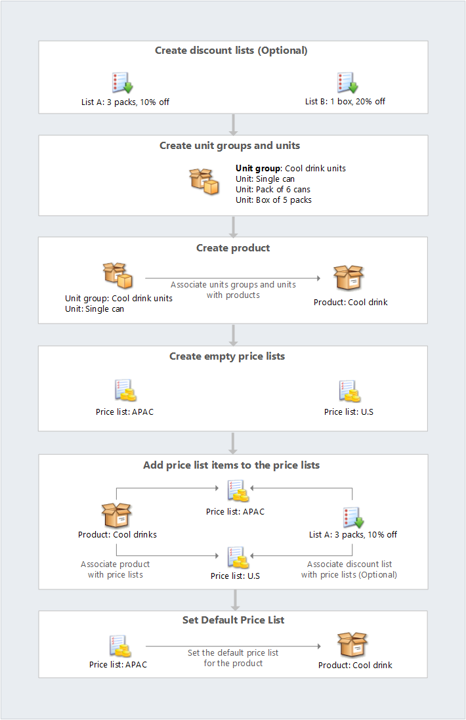Dynamics 365 product catalog overview
A product catalog is a collection of products and services that an organization sells and provides to customers. It includes pricing information. A typical product catalog not only includes a list of the products that an organization sells but also defines different pricing tiers, like retail and wholesale, and quantity levels on how a product will be sold.
Microsoft Dynamics 365 includes a product catalog that lets organizations create a rich product classification system that supports the following actions:
Define a hierarchical structure of product families and products that have configurable properties (attributes). These attributes help you reduce the number of product stock keeping units (SKUs) that are required to maintain your product catalog.
Sell individual products, or group them into bundles and kits. A bundle or a kit is a collection of products that's sold as a single unit. Product bundling is useful for grouping products in such a way that customers will benefit from the full line of products. It also lets you offer discounts on bundled products.
Define related products in the system. (For example, these related products might be substitute, cross-sell, up-sell, or accessory products.) The related products for a product are shown to sales agents as suggestions when they add the product to an opportunity, quote, order, or invoice.
Define multiple pricing and discounting models. You can also use custom pricing instead of the Dynamics 365 system pricing to calculate prices when you associate a product or bundle with an opportunity, quote, order, or invoice. Additionally, you can select whether to apply discounts for products at the per-unit level or the line level.
Specify whether the price level (that is, the price list) should be automatically set for an opportunity, quote, order, or invoice, based on the user's sales territory relationship.
Specify localized values for some product properties (attributes) to make the product names and descriptions available in user-preferred languages.
Product catalog components
The Dynamics 365 product catalog consists of four components:
Unit groups: A unit group defines how a product is packaged for sale. Among other values, it defines the units of measure that the product or service is sold in. For example, an organization that sells gaming systems might sell them individually on a crate that includes 12 individual gaming systems. An organization that provides services to customers might sell their services in increments of hours, days, or weeks.
Products: A product represents the type of product that a company might keep in inventory, a product that's custom-built, or a service that's provided to a customer. For example, a beauty salon's product list might include different hair styling products and also services like haircuts, hair coloring, and spa services.
Price lists: A price list is a set of prices that are charged for products under specific circumstances. For example, an organization might have multiple price lists to accommodate seasonal variations, specials, or the different markets that the organization sells to (like government, commercial, and education).
Discount lists: A discount list lets organizations offer products or services at different prices, depending on the quantity that's bought. For example, a small vendor that buys five TVs to sell in its store might pay 350.00 US dollars per TV. A large vendor that buys 500 TVs to sell in multiple locations might pay 300 US dollars per TV.
Note
Of all the components in the preceding list, only discount lists aren't required. All other components must be set up for any organization that will use the product catalog.
Because of the way that units, discounts, and prices are linked, it's important that you create the components in a product catalog in the following order.
